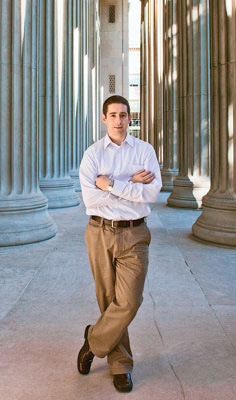Pioneering Research Brings Kudos for John Sullivan ’04
The innovative research of John Sullivan ’04, who recently received his master’s in real estate development from the Massachusetts Institute of Technology, has been recognized with two awards.
 Sullivan and his coauthor, Benjamin Bulloch, principal of Credit Tenant Capital, Boston, received the ING Clairon Most Outstanding Student Article Award for an article published in Cornell Real Estate Review. Their pioneering research explores the application of a tool called the Design Structure Matrix to the real estate development process. It is the first time that DSM, a process model used in the design and development of complex engineering products, has been applied to real estate.
Sullivan and his coauthor, Benjamin Bulloch, principal of Credit Tenant Capital, Boston, received the ING Clairon Most Outstanding Student Article Award for an article published in Cornell Real Estate Review. Their pioneering research explores the application of a tool called the Design Structure Matrix to the real estate development process. It is the first time that DSM, a process model used in the design and development of complex engineering products, has been applied to real estate.
The article, “Information: The Key to the Real Estate Development Process,” appeared in the July 2010 issue. It was based on their master’s thesis research, for which they received the Outstanding Thesis award from the Alumni Association of MIT’s Center for Real Estate.
Cornell Real Estate Review is the country’s premier student-managed scholarly journal in the real estate field. It features articles by scholars, professional practitioners, and students from all fields related to the real estate profession.
Sullivan is founder and principal of AspinWall Partners LLC, Brookline, Mass., a real estate investment firm. As noted in MIT’s web feature on the company, AspinWall did proforma modeling and analysis (predicting the results) of a residential project in Greater Boston and conducted an income-based valuation to acquire and reposition a 10,000-square-foot retail center.
The chance to combine engineering and the liberal arts was the reason he chose Lafayette, and his studies have paid dividends. Real estate development is “one of the most multidisciplinary fields that exists,” says the engineering studies and economics & business graduate. “The field incorporates finance, economics, engineering, architecture, construction, and many other topics that mirror those covered during my time at Lafayette.”
The opportunity to work closely with faculty on research led Sullivan to a summer internship. He worked with David Veshosky, associate professor of civil and environmental engineering, on research related to the most expensive highway project in the United States, Boston’s Central Artery/Tunnel project, the “Big Dig.” Veshosky put Sullivan in touch with Boston-area alumni, which led to an internship with the international construction management company Bovis Lend Lease. That internship turned into a full-time position with Bovis, which Sullivan held until returning to MIT.
“My undergraduate thesis taught me the iterative process that occurs during research. In both undergraduate and graduate work, students are striving to research new topics in new ways. Because of the exploratory process, you often hit dead ends, or come up with results that are unexpected. I learned this at Lafayette, which better prepared me for undertaking another thesis at MIT.”